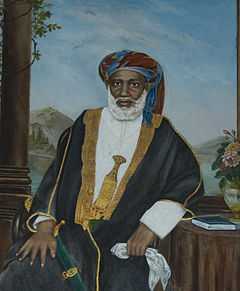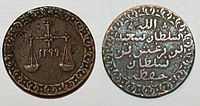Swahili people
 | |
| Total population | |
|---|---|
| 8.2 million | |
| Regions with significant populations | |
| Tanzania (particularly Zanzibar) (~8 million), Kenya (110,614),[1] Mozambique | |
| Languages | |
| Swahili | |
| Religion | |
| Islam | |
| Related ethnic groups | |
| Mijikenda, other Bantu peoples |
The Swahili people (or Waswahili) are an ethnic and cultural group inhabiting the African Great Lakes region. Members mainly reside on the Swahili Coast, in an area encompassing the Zanzibar archipelago, coastal Kenya, the Tanzania seaboard, and northern Mozambique. The name Swahili is derived from the Arabic word Sawahil سواحل, meaning "coasts". The Swahili speak the Swahili language, which belongs to the Bantu branch of the Niger-Congo family.
Definition
The Swahili people originate from Bantu inhabitants of the coast of Southeast Africa, in Kenya, Tanzania and Mozambique. They are mainly united under the mother tongue of Kiswahili, a Bantu language.[2] This also extends to Arab, Persian, and other migrants who reached the coast some believe as early as the 7th or 8th century AD, and mixed with the local people there, providing considerable cultural infusion and numerous loan words from Arabic and Persian.[3] Archaeologist Felix Chami notes the presence of Bantu settlements straddling the Southeast African coast as early as the beginning of the 1st millennium. They evolved gradually from the 6th century onward to accommodate for an increase in trade (mainly with Arab merchants), population growth, and further centralized urbanization; developing into what would later become known as the Swahili City-States.[4]
Religion
.jpg)
Islam established its presence on the Southeast African coast from around the 9th century, when Bantu traders settling on the coast tapped into the Indian Ocean trade networks. Because of the interactions that ensued with the Arab and Somali proselytizers, Islam emerged as a unifying force on the coast and helped to form a unique Swahili identity.[5]
On the coastal section of Southeast Africa, a mixed Bantu community gradually developed through contact with Muslim Arab and Persian traders. The Swahili culture that emerged from these exchanges evinces many Arab and Islamic influences not seen in traditional Bantu culture, as do the many Afro-Arab members of the Bantu Swahili people.[6][7] The Afro-Arab Swahili people in turn introduced the Islamic faith to the hinterland.[7]
The Swahili follow a very strict and orthodox form of Islam. For example, Eid-ul-Fitr, the holiday marking the end of Ramadan, is widely celebrated in areas where the Swahili form a majority.[8] Further, large numbers of Swahili undertake the Hajj and Umrah from Tanzania,[9] Kenya,[10] and Mozambique.[11] Traditional Islamic dress such as the jilbab and thob are also popular among the Swahili. In addition to more orthodox practices, the Swahili also are known for their use of divination, which has adopted some syncretic features from underlying traditional indigenous beliefs. In addition to orthodox beliefs in djinn, many Swahili men wear protective amulets around their necks, which contain verses from the Qu'ran. Divination is practiced through Qur'anic readings. Often the diviner incorporates verses from the Qur'an into treatments for certain diseases. On occasion, he instructs a patient to soak a piece of paper containing verses of the Qur'an in water. With this ink infused water, literally containing the word of Allah, the patient will then wash his body or drink it to cure himself of his affliction. It is only prophets and teachers of Islam who are permitted to become medicine men among the Swahili.[2]
Language
The Swahili speak the Swahili language as their native tongue, which is a member of the Bantu subgroup of the Niger-Congo family. Its closest relatives include Comorian spoken on the Comoros Islands, and the Mijikenda language of the Mijikenda people in Kenya.[12]
With its original speech community centered on the coastal parts of Zanzibar, Kenya and Tanzania, a seaboard referred to as the Swahili Coast, the Bantu Swahili language contains many Arabic loan-words as a consequence of interactions with Arab migrants.[6] Swahili became the tongue of the urban class in the Great Lakes region, and eventually went on to serve as a lingua franca there during the post-colonial period.[7]
Economy
For centuries the Swahili depended greatly on trade from the Indian Ocean. The Swahili have played a vital role as middle man between southeast, central and South Africa, and the outside world. Trade contacts have been noted as early as 100 AD. by early Roman writers who visited the Southeast African coast in the 1st century. Trade routes extended from Somalia to Tanzania into modern day Zaire, along which goods were brought to the coasts and were sold to Arab, Indian, and Portuguese traders. Historical and archaeological records attest to Swahilis being prolific maritime merchants and sailors[13][14] who sailed the Southeast African coastline to lands as far away as Arabia,[15] Persia,[15] Madagascar,[13] India[14][16] and even China.[17] Chinese pottery and Arabian beads have been found in the ruins of Great Zimbabwe.[18] During the apogee of the Middle Ages, ivory and slaves became a substantial source of revenue. Many slaves sold in Zanzibar ended up in Brazil, which was then a Portuguese colony. Swahili fishermen of today still rely on the ocean to supply their primary source of income. Fish is sold to their inland neighbors in exchange for products of the interior.
Although most Swahili live with living standards far below that of the first world, the Swahili are generally considered a relatively economically powerful group due to their history of trade. They are comparatively well-off; for example, according to the United Nations, Zanzibar has a 25% higher per capita GDP than the rest of Tanzania.[19] This economic influence has led to the continued spread of their culture and language throughout East Africa.
Architecture
Previously thought by many scholars to be essentially of Arabic or Persian style and origin; archaeological, written, linguistic, and cultural evidence instead suggests a predominantly African genesis and sustainment. This would be accompanied later by an enduring Arabic and Islamic influence in the form of trade, inter-marriage, and an exchange of ideas.[20][21] Upon visiting Kilwa in 1331, the great Berber explorer Ibn Battuta was impressed by the substantial beauty that he encountered there. He describes its inhabitants as "Zanj, jet-black in colour, and with tattoo marks on their faces", and notes that "Kilwa is a very fine and substantially built town, and all its buildings are of wood" (his description of Mombasa was essentially the same).[22] Kimaryo points out that the distinctive tattoo marks are common among the Makonde. Architecture included arches, courtyards, isolated women's quarters, the mihrab, towers, and decorative elements on the buildings themselves. Many ruins may still be observed near the southern Kenyan port of Malindi in the Gede ruins (the lost city of Gede/Gedi).[23]
Notable people
Tanzania
- Shaaban Bin Robert
Zanzibar

- Salim Ahmed Salim, The Sixth Secretary General of the OAU
- Seif Sharif Hamad, Vice President of Zanzibar
- Ali Mohamed Shein, The seventh President of Zanzibar
- Amani Abeid Karume, The sixth President of Zanzibar
- Abeid Karume, The first President of Zanzibar
- Abdulrahman Mohamed Babu, Zanzibari revolutionary nationalist
- Ali Karume, Tanzanian Ambassador to Italy
- Salmin Amour, The fifth President of Zanzibar
- Shamsi Vuai Nahodha, Former Chief Minister of Zanzibar
- Zakia Meghji, Former Minister of Finance
- Ali Hassan Mwinyi, The second President of Tanzania
- Mwinyi Aboud Jumbe, The second President of Zanzibar
- Hussein Mwinyi, Minister of Health and Social Welfare
- Rashid Seif Suleiman, Minister of Communication and Infrastructure
- Seif Rashid, Deputy Minister of Health and Social Welfare
- Mohamed Aboud Mohamed, Minister of State
- Shaykh Abdullaah Swaalih Al-Farsy
- Tippu Tip
- Barghash bin Said
- Siti binti Saad
- Sayyida Salme
- Said Salim Bakhresa Businessman
Kenya
- Suleiman Shahbal
- Najib Balala
- Suleiman Saleh
- Prof. Abdulghafur El-Busaidy
- Prof. Ali Al'amin Mazrui Prof. Ali Al'amin Mazrui
Comoros
- Mohamed Djaanfari
- Ahmed Abdallah Mohamed Sambi
- Ikililou Dhoinine
- Hamada Madi
- Djoueria Abdallah
- Said Dhoifir Bounou
See also
- Swahili language
- Swahililand
- Swahili architecture
- Swahili culture
References
- ↑ http://www.knbs.or.ke/censusethnic.php
- ↑ 2.0 2.1 http://www.uiowa.edu/~africart/toc/people/Swahili.html
- ↑ Gilbert. Coastal East Africa and the Western Indian Ocean
- ↑ African Archaeological Review, Volume 15, Number 3, September 1998, pp. 199-218(20)
- ↑ Christine Stephanie Nicholls, The Swahili coast: politics, diplomacy and trade on the East African littoral, 1798-1856, Africana Pub. Corp., 1971
- ↑ 6.0 6.1 Daniel Don Nanjira, African Foreign Policy and Diplomacy: From Antiquity to the 21st Century, ABC-CLIO, 2010, p.114
- ↑ 7.0 7.1 7.2 Harvey J. Sindima, Religious and political ethics in Africa: a moral inquiry, Greenwood Publishing Group, 1998, page 144
- ↑ http://zanzibar.net/music_culture_festivals_events/religious_festivals_-_eid_ul_fitr
- ↑ http://news.bbc.co.uk/2/hi/africa/7140977.stm
- ↑ http://allafrica.com/stories/200911191155.html
- ↑ http://www.hajinformation.com/display_news.php?id=1432
- ↑ William Frawley, International encyclopedia of linguistics, Volume 1, (Oxford University Press, 2003), page 181
- ↑ 13.0 13.1 African History A history of Sub-Saharan Africa. By Robert O. Collins, James McDonald Burns. pgs. 109-112, (2007) Cambridge University Press, accessed February 15, 2012.
- ↑ 14.0 14.1 The Earth and Its Peoples: A Global History, Volume 2 By Richard Bulliet, Pamela Kyle Crossley, Daniel Headrick, Steven Hirsch, Lyman John. pg. 381, (October 2006) Wadsworth Publishing, accessed February 15, 2012.
- ↑ 15.0 15.1 The East African Slave Trade BBC, BBC, accessed February 15, 2012.
- ↑ The Encyclopaedia of Islam, Volume 3, Part 2. By Sir H. A. R. Gibb. pg. 206, (2001), accessed February 15, 2012.
- ↑ Swahili-Chinese interaction The Cambridge History of Africa: From c. 1050 to c. 1600. By J. D. Fage. pg. 194, (1977), Cambridge Publications, accessed February 15, 2012.
- ↑ Garlake (2002) 184-185
- ↑ http://data.un.org/Data.aspx?q=Zanzibar&d=SNAAMA&f=grID:101;currID:USD;pcFlag:1;crID:836
- ↑ East African Coastal Historical Towns: Asiatic or African? - by Jacob L. Kimaryo (2000)
- ↑ Mark Horton, Shanga: a Muslim Trading Community on the East African Coast (Nairobi: 1996)
- ↑ Ibn Battuta: Travels in Asia and Africa 1325-1354 - Medieval Sourcebook, Retrieved on 2007-08-28.
- ↑ Ruins of the walled city of Gedi, Kenya
F. Le Guennec-Coppens et D. Parkin, Autorité et pouvoir chez les Swahili, Karthala, 1998, p. 262
External links
| Wikisource has the text of the 1905 New International Encyclopedia article Swahili. |
- The Story of Africa: The Swahili — BBC World Service
- Swahili Culture
-
 "Swahili". Encyclopædia Britannica (11th ed.). 1911.
"Swahili". Encyclopædia Britannica (11th ed.). 1911.
| ||||||||||||||||||||||

